Radiate
March 16 – September 17, 2023

Cosmic Cascade, 2022
Acrylic on canvas


J Ivcevich
Untitled (Silver Tree Gold Mandala), 2018
Mixed Media
70 x 50 in. overall
JI123

Ground Zero V, 1991
Handmade paper monotype

Tiger, Tiger, 2015
flashe on linen mounted on panel

Coral Cascade, 2022
Acrylic and acrylic spray paint on canvas

Handbell Bling Swing, 2020
Oil and plaster on canvas
76.20h x 101.60w cm

Gouache on panel

Gouache on panel

Gouache Flashe on Panel

Gouache on panel

Gouache on panel

Untitled (Silver Tree Gold Mandala), 2018

Diadema Red and Green, 2014
graphite and flashe on linen mounted on panel

Handbell Bling Swing, 2020
Oil and plaster on canvas

Radiate
March 16 – September 17, 2023
(Tribeca, New York) Garvey|Simon is pleased to present Radiate, a group exhibition of abstract paintings, drawings, and works on paper centered on the formal exploration of radiant light and color. Though vastly different, the compositions of all of these works are predicated on a basic gesture: the outward progression from an internal point of origin. The artists show this structure to be all-encompassing, meditative, spontaneous, deliberate, minimal, and maximal – and use the intensely layered nature of the form to deny a singular, simple reading. In Radiate, these emanating layers take on a multitude of shapes, including petal-like structures, multicolored striations, geometric figures, delicate lines, and rich baths of color. Radiate features artwork from Michael David, Patricia Fabricant, J Ivcevich, Mary Judge, Jenifer Kent, Carolanna Parlato, and Danielle Riede. The exhibition opens with a reception on March 16, 2023 at Artisan Lofts, 143 Reade Street in Tribeca, 5-7pm. After the reception, the exhibition will be on view by appointment only. Call 917-796-2146 to schedule or contact Liz Garvey. [email protected]
Michael David
The monotype in this show, Ground Zero V, is one of Michael David’s “target” works from the early 1990’s. Created with Pace Editions, the artist achieves a unique marriage of pigment and ground as the paint is literally fused into the tactile handmade paper. The textural quality of this work is reminiscent of the artist’s paintings in encaustic. Different levels of meaning can be interpreted from the concentric circles of this poetic composition: the solar system, cells, bullseyes. The work also relates to David’s continual examination of the Doppelganger. The asymmetrical pair of radials stares out, hypnotic in their attraction. Michael David, a Guggenheim Fellow artist, has been exhibiting his paintings internationally since 1981, first with Sidney Janis Gallery and then with M. Knoedler & Co. for over two decades. His work is included in the permanent collections of the Metropolitan Museum of Art, the Guggenheim Museum, and The Brooklyn Museum in New York; The Houston Museum of Contemporary Art, and the Denver Museum of Contemporary Art to name a few. He was the subject of a one -person exhibition at Aspen Museum of Art.
Patricia Fabricant
Patricia Fabricant’s radials take an organic, sometimes animalistic form, populating her canvases with seed, scale, and wave-like shapes. Interested in the tension between decoration and art, Fabricant leans into abundance, packing her paintings with swells of color and frenetic energy. Though electric, Fabricant’s process is meditative. She allows shapes and lines to reveal themselves as they launch from the center of her compositions. Patricia Fabricant is a painter, curator, and award-winning book designer, born in New York City. She received her BA from Wesleyan University and studied painting in Florence, Italy. Her abstract and figurative paintings have been exhibited widely at such galleries as M David & Co, Front Room, SFA Projects, Equity Gallery, Morgan Lehman, the Painting Center, and 490 Atlantic. She lives and works in Brooklyn, NY.
J Ivcevich
J Ivcevich blends innovative drafting technologies with traditional artisanal craft to create his abstract paintings. Drawing from images of tattered street advertisements, Ivcevich begins by manipulating the canvas surface with tie-dye and silk-screen techniques. Imagery taken from the found advertisements is then put through a process of layering and compositional reduction, then flipped, mirrored, and tessellated into a bursting mandala of forms. J Ivcevich received his Bachelor of Arts from Emory University in 1994. He was the recipient of the Pollock-Krasner Grant in 2001 and was featured on the cover of New American Paintings in both the Southeast and Northeast editions. Ivcevich has had solo exhibitions in New York, Indianapolis, Washington D.C., Chicago, Atlanta, and Memphis. A painting from this series is part of the Art in Embassies collection in Laos.
Mary Judge
Mary Judge’s geometric abstract paintings pull from her experience working with Italian frescos and ceramics. Her understanding of pattern and scale bring an immersive quality to her work. Her forms do not merely fold out from the center of the composition, rather, there is the sense that they could break out of the pictorial plane, replicating endlessly and with deft precision. Mary Judge attended Moore College of Art in Philadelphia, (BFA), Skowhegan School of Painting and Sculpture, Maine and Tyler School of Art (MFA), graduating from the Rome campus. Judge worked for several years with the Grazia factory in Deruta, painting for the design market while maintaining her fine art studio practice. Her works are in The Philadelphia Museum of Art, The Fogg Art Museum, The Corcoran Gallery of Art, The British Museum, The Victoria and Albert Museum and the Museo d’Arte Contemporanea di Cassino, Italy. Mary Judge currently divides her time between New York and Puglia, Italy.
Jenifer Kent
Jenifer Kent’s abstract ink drawings are as simple as they are labyrinthine. Kent uses a constrained language of mark-making to create her radial compositions. Surging out from a single origin point, minuscule ink marks ebb and wane. They are guided not by uniform measurement, but by the rise and fall of sound waves, the acceleration and lethargy of movement, and Kent’s own internal rhythm. Jenifer Kent has had multiple solo exhibitions throughout the Bay Area and has been featured in both solo and group exhibitions in California, New York, Florida, and North Carolina. She is the recipient of the 2018 Wildlands Artist Residency Award and is included in the permanent collection of the Alameda County Art Collection, Alameda, CA. Jenifer Kent lives and works in Montague, CA.
Carolanna Parlato
Carolanna Parlato uses her vibrant, diaphanous puffs of color to punctuate the layered textures of paint beneath them. These bold visual interruptions stand in stark contrast to their tightly-woven acrylic neighbors; an explosive surprise in the otherwise ordered mesh-like ground. Carolanna Parlato has exhibited widely in New York City and throughout the U.S. since the 1990s. Her paintings have been written about in numerous publications including The New York Times, Art in America, The Boston Globe, Artcritical, ArtNews, The New Criterion, White Hot Magazine, and The Brooklyn Rail. Solo exhibitions include the Islip Art Museum; the Phatory (NYC); Elizabeth Harris Gallery (NYC); and Morgan Lehman Gallery (NYC). Public collections include the Brooklyn Museum; ArtBank Collection (DC); The Library of Congress (DC); Public Art for Public Schools (NYC); the Francis Greenburger Collection (NYC); the Islip Art Museum, Presbyterian Hospital and the Art in Embassies Program, Guatemala City. Parlato received her MFA from the San Francisco Art Institute. She currently lives and works in Brooklyn, NY.
Danielle Riede
Danielle Riede’s glimmering striations of color overlap and mingle, like ripples spilling out from stones dropped in water. The semi-transparency of her pigment gives her painting a sense of depth and volume. Her ripples not only push out from the center, but also build atop one another. Inspired by dance and the ephemerality of nature’s motion, Danielle Riede uses paint to transfer movement’s invisible pathways onto canvas. She received her Master of Fine Arts in Painting from Virginia Commonwealth University and also studied with Daniel Buren at the Kunstakademie Duesseldorf. Her international exhibition record includes galleries and museums in Mexico City, Athens, Berlin, and New York, to name a few. Danielle Riede is the recipient of numerous awards including the Virginia Museum of Fine Arts Fellowship, the Virginia Commission for the Arts Fellowship in Sculpture, a New Frontiers Grant from Indiana University, and the 2021 IAHI grant from Indiana University. She is currently the Randolph H. Deer Professor of Painting at Herron School of Art and Design, Indianapolis.
For viewing appointments, more information, high resolution images, or sales inquiries, please contact Elizabeth Garvey at [email protected], or 917-796- 2146.
Methods for making acrylic paintings radiate
Radiating lines are used by master artists in composition to tie specific elements together from a single point, much like the spokes on the wheel of a bicycle. Using radiating lines creates a sense of unity and allows the eye to travel within the work of art smoothly. In the painting below, “Marriage of Bacchus and Ariadne,” notice how Tintoretto is using radiating lines from the pivot point of the composition.
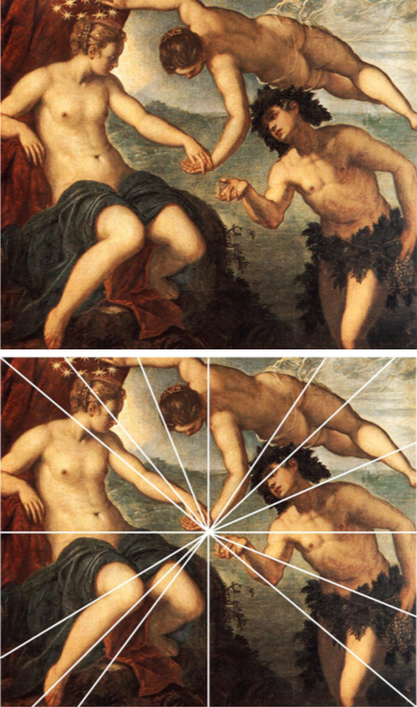
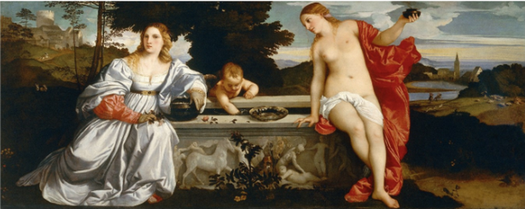
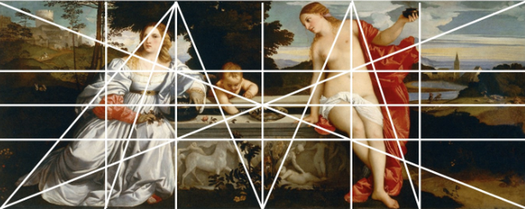
Painting above, “Sacred and Profane Love” by Titian, demonstrating the use of radiating lines
generated from the armature of the rectangle.
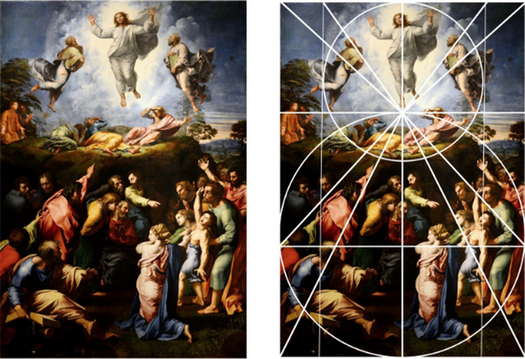
Painting above, “Transfiguration” by Raphael, demonstrating the use
of radiating lines generated from rabatment of the rectangle
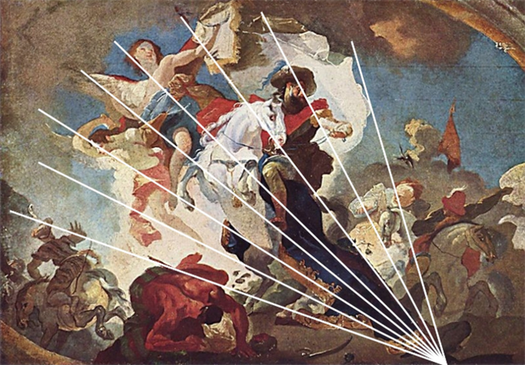
Painting above by Franz Anton Maulbertsch demonstrating the use of radiating lines.
Recommended Videos
Help Me Help You
Not having any paywalls or charging for products gives me a global advantage over others teaching the art of composition. I can reach thousands of artists and photographers worldwide without asking them to open their wallets.
I’m not influenced by trends in marketing, I don’t shape the content of my articles and videos to sell products, and I make no money on the books or videos I promote. I only have one interest in mind. Learning as much as I can about art and design and sharing that knowledge with those that visit my website. All for free.
Ever since I got my first camera in 1982, I have been passionate about taking better photographs. Spending all of my teenage years in my father’s darkroom taught me a lot. I learned all of Ansel Adams’ techniques on the zone system and swiftly moved into street photography from there.
I was heavily influenced by photographers like Henri Cartier-Bresson and Elliott Erwitt. And like many other amateur photographers, I wanted to learn how to shoot like the “masters.” But unfortunately, sometimes our passion is limited by our lack of knowledge and experience. In other words, I kept hitting a wall with my progress regardless of how many photobooks I purchased or how many hours I spent shooting. What was missing in all of my images? One thing. My understanding of design.
Unfortunately, throughout most of my photographic journey, there has been very little written on the topic of composition. In fact, when I say “very little,” I mean almost nothing. And sure, you could argue the fact that you can jump on any photography website and find a few cherry-picked concepts like the rule of thirds and the golden section. But this isn’t enough. Not even close.
One day, in an intense effort to research information on composition, I stumbled upon the Barnstone Studios DVDs. To say I was excited would be an understatement. I immediately purchased the ten disc set and watched them for over a decade. That’s where my true journey began.
From that point on, I have spent all my free time researching the art of composition. No easy task. Was this an obsession of mine? Sure, I would never argue that fact. But with everything in life, there are always unseen benefits when you set out to do something to improve yourself or your craft.
After spending many years studying design, I realized that other artists could benefit from the information I have discovered. In truth, my website The Art of Composition is a reflection of my passion and desire to learn. For those that have taken the time to visit my website, I want to thank you for stopping by. But more than that, I hope that you find the free books and videos beneficial and worth your time.
If you like this website and the information I provide, please feel free to make a donation. Any amount will help. With inflation on the rise, and the price of everything going up, it’s getting more difficult to keep this website alive. With your generous help, you can keep my research moving forward and allow me to help you, the dedicated artist and photographer.
This website relies solely on donations for support.

The Art of Composition
A Simple Approach for Creating Masterful Designs
The Art of Composition: A Simple Approach for Creating Masterful Designs evolved from my personal and professional experience as a photographer, master level darkroom technician, and graphic designer. After years of applying the same “popular” rules of composition to my images and designs, I reached a point in my artistic career where I was no longer able to improve my portfolio regardless of how much time and money I invested in photography workshops, photography books, and high-end camera equipment.
Realizing I was getting nowhere with the Rule of Thirds, the Rule of Odds, the Rule of Space, and Leading Lines, I began an intensive search for any information I could find on real design principles. I read every art and design book I could get my hands on and spent endless days and nights analyzing over five thousand works of art. The Art of Composition: A Simple Approach for Creating Masterful Designs is a series of personal analytical notes that reflect this ten-year study.
By sharing this collection of analytical notes with other artists and photographers, I hope to save them years of frustration and wasted time as well as put them on the most productive path for improving their lifetime body of work. While other books written on composition tend to focus on incorporating complex design methods using overlapped Dynamic Symmetry root rectangles, this user’s guide takes a one grid approach to teaching that will make it easier for the artist and photographer to learn the art of composition at the quickest rate possible.





